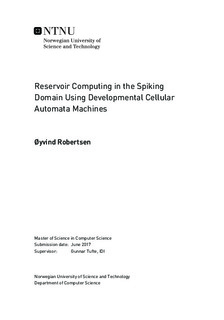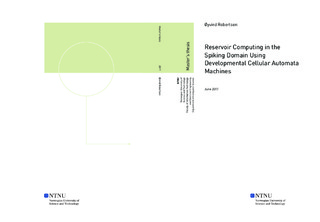| dc.description.abstract | As computer systems and networks grow in size and complexity, traditional top-down en- gineering techniques are quickly beckoming inadequate for achieving the desired results. Designing such systems that are robust and resilient, are able to adapt and self-regulate, can self-reproduce and learn autonomously is a tremendously hard task. These features are however present in many biological organisms, wherein they emerge through evolu- tion and development. In the fields of unconventional and biologically inspired computing, these techniques are used to create computing systems with the same type of complexity as that found in biological systems. Cellular Automata (CAs) are an example of a biolog- ically inspired computing system that can achieve complex, global computation through local interaction between simple cells at a vast scale.
While the computational capabilities of CAs have been researched extensively, they have not seen mainstream adaption as a computational paradigm. Programmability and encod- ing/decoding of input/output are two major challenges facing cellular computing systems. Manually specifying the functionality of each cell in such a way that the desired emergent global behavior of the CA as a whole is achieved, is infeasible for non-trivial systems. Problem input is usually encoded in the initial state of the system, and output is decoded from the state after the system has been simulated some amount of time.
The Cellular Automata Research Platform (CARP) is an FPGA-based implementation of a developmental cellular architecture, aiming to facilitate research into use of artificial development and evolution to create cellular computing systems. At an abstract level, it implements a dynamical system with dynamical structure (DS)2, a system for which both behavior and structure are emerging properties. Behavior influences further structural development and vice versa.
In this thesis, the platform is extended to incorporate the developmental CA into a reser- voir computing architecture. Reservoir computing (RC) is a novel approach to machine learning in which temporal input is imposed as perturbations on a dynamic reservoir and output is read out by performing a linear classification of the reservoir state some time af- ter the initial perturbation. By combining RC and developmental CAs, the CARP system solves many of the issues relating to programming of and I/O encoding/decoding with cel- lular computing systems. It also opens up new possibilities for the developed organisms to adapt and learn based on their environment. The CARP platform has been extended with a reconfigurable readout layer implemented as a spiking neural network (SNN) that classifies the dynamics of the reservoir, the developmental CA. An SNN is chosen to allow the system operate entirely in the spiking domain, as input data and the dynamic behavior of the reservoir is already spiking in nature.
The extended platform has been verified through extensive testing, both in simulation and end-to-end on actual hardware. | |

